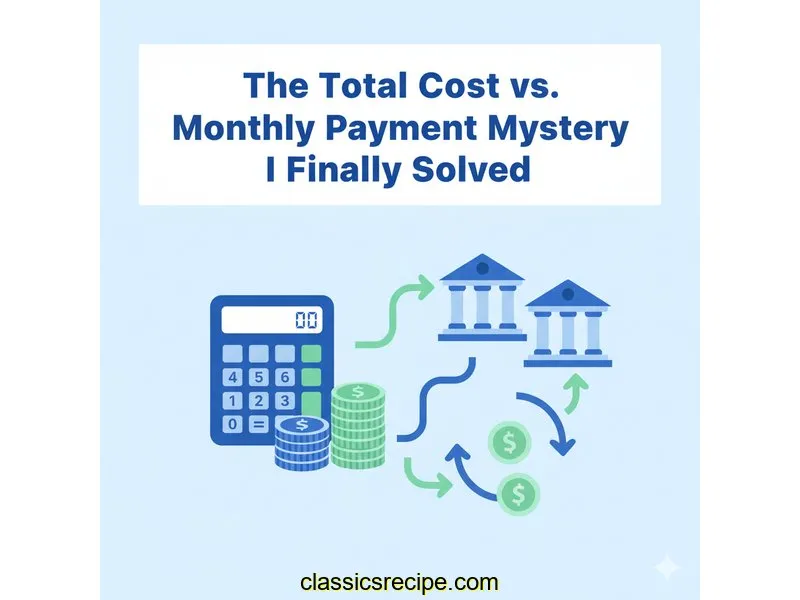
Auto Loan Calculator
Calculate payments over the life of your Loan
Home Blog Privacy Terms About Contact
Calculate payments over the life of your Loan
Home Blog Privacy Terms About ContactPublished on October 14, 2025

My journey into the weeds of loan calculations started with a simple, offhand conversation. A friend mentioned the great deal they got on a loan for some home improvements. "The monthly payment is so low, I barely notice it," they said. I remember nodding along, thinking that a low monthly payment was the ultimate goal, the very definition of a "good deal." But then they mentioned the total loan amount, which was similar to one I had been researching, and my mental math started to fizzle.
Their payment seemed significantly lower than what I was seeing in my own explorations with online calculators. How was that possible? For a few days, that question just rattled around in my head. Was their credit that much better? Did they find some secret lender? It felt like I was missing a key piece of information. This wasn't about wanting a loan myself; it was about a fundamental gap in my understanding. I realized I didn't actually know how a monthly payment was calculated, or what factors could make it go up or down.
So, I set a simple goal for myself: to understand the relationship between all the numbers in a loan. I wanted to be able to look at a loan amount, an interest rate, and a term, and have a genuine feel for what the payments and total costs should be. I wanted to solve the mystery of my friend's "unbelievably low" payment. This is my journey of figuring that out, a deep dive into the numbers behind the numbers. Please remember, this is about understanding how calculations work, not financial advice.
My initial attempts were clumsy. I'd open an online loan calculator, plug in some numbers, and stare at the result. But I was only looking at one number: the monthly payment. It was the only one that seemed to matter to me at the time, because it felt like the most tangible, real-world figure. I was about to learn that focusing on that single number meant I was missing the entire story.
My initial confusion was rooted in a simple but powerful bias: I was laser-focused on immediate affordability. When I started playing with online calculators, the "Estimated Monthly Payment" box was like a magnet for my eyes. To me, that number represented the loan's impact on my monthly budget, and everything else seemed like abstract financial jargon. This narrow focus led me straight into a calculation puzzle I couldn't solve.
I decided to use a hypothetical scenario to reverse-engineer my friend's situation. I plugged in a loan amount of $14,850 at an interest rate of 7.2%. First, I set the loan term to 48 months (4 years). The calculator spit out a monthly payment of about $357.73. "Okay," I thought, "that seems reasonable, but it's much higher than what my friend described."
Then, I remembered they mentioned it was a longer loan. So, I kept the $14,850 and the 7.2% rate, but I changed the term to 72 months (6 years). The calculator updated, and the magic number appeared: $254.43. That was it! That was the low payment that had seemed so appealing. For a moment, I felt a sense of triumph. It was simple: longer term equals lower payment. Case closed, right?
But something still felt off. It seemed too easy, like a magic trick. How could stretching out the payments reduce the cost so much? My mistake was thinking the monthly payment was the cost. I spent an entire evening running different scenarios, but I kept coming back to the same flawed conclusion. I was comparing the $254 payment to the $358 payment and thinking the first one was over $100 "cheaper" each month. The frustration was immense. I knew I was missing something fundamental about how interest actually works over time.

The breakthrough came not from a complicated formula, but from simple curiosity. Frustrated, I finally forced my eyes away from the "Monthly Payment" field and scanned the rest of the calculator's output. There, usually in smaller font, were two other fields I had been completely ignoring: "Total Interest Paid" and "Total Cost of Loan." This was the moment everything clicked into place.
I ran my two scenarios again. The 48-month loan at $357.73 per month showed a "Total Interest Paid" of $2,321.04. The 72-month loan at the "cheaper" $254.43 per month showed a "Total Interest Paid" of $3,468.96. I stared at the screen for a solid minute. The lower monthly payment came at the cost of over $1,100 extra in interest. The "cheaper" loan was actually far more expensive. It wasn't a magic trick; it was just math I hadn't taken the time to understand. The calculator wasn't just giving me a monthly payment; it was telling a complete financial story, and I had only been reading the first sentence.
My first big realization was that the loan term isn't just a timeline; it's a multiplier. With the 48-month loan, I was making 48 payments. With the 72-month loan, I was making 72 payments. That's 24 extra payments. Even though each individual payment was smaller, every single one of those 72 payments included an interest component. More payments simply meant more chances for interest to be calculated on my remaining balance.
This became my new anchor point. I started to see the "Total Interest Paid" as the price tag for borrowing money. The loan amount is what you get, but the total interest is what you pay for the service of getting it. Shifting my focus from the monthly payment to this number felt like switching from looking at a car's monthly lease price to looking at its final sticker price. Both are important, but only one tells you the full cost.
To make sure I really understood, I started running more and more scenarios. What about a smaller loan? I modeled a $9,500 loan at 8.1%. Over 36 months, the payment was about $296, and the total interest was $1,157. Over 60 months, the payment dropped to $195, but the total interest soared to $2,185. The pattern held. The lower payment always came with a higher long-term cost. It wasn't a fluke; it was the fundamental mechanics of how loan amortization works.
After spending a weekend diving into calculators and seeing the numbers interact, my entire perspective on loan math changed. It wasn't just about finding a low payment anymore; it was about understanding the entire financial equation. Here are the core lessons I learned about the calculations themselves.
From what I've learned, it's all about time. A lower monthly payment is usually achieved by extending the loan's term (e.g., from 48 to 72 months). While you pay less each month, you make many more payments. Each of those extra payments includes interest calculated on the remaining balance, so the total amount of interest you pay over the life of the loan increases significantly.
While every number is part of the story, I've come to believe that for understanding the true expense, the "Total Interest Paid" is the most critical comparison point. It strips away everything else and shows you the raw cost of borrowing the money. The monthly payment is about affordability, but total interest is about overall cost.
The term acts as a multiplier. The longer the term, the more time the lender has to charge interest on your declining balance. Even though your balance is going down, spreading it over more time means the cumulative interest adds up to a much larger number. A shorter term means you pay off the principal faster, giving interest less time to accumulate.
Amortization is the process of spreading out loan payments over time. An amortization schedule shows you, for every single payment, how much is going toward interest and how much is going toward paying down your principal. In the beginning of a loan, a larger portion of your payment goes to interest. A longer loan term keeps you in that high-interest phase for longer, which is why the total cost is higher.
My quest started with a simple question about a friend's low monthly payment and ended with a profound shift in my own financial literacy. The single greatest lesson was realizing that the most seductive number—the low monthly payment—can often hide the most important number: the total cost. Seeing that a $254 monthly payment was over a thousand dollars more expensive in the long run than a $358 one was a true lightbulb moment.
It taught me that online calculators are powerful tools for understanding, not just for getting a single answer. By playing with the inputs and, more importantly, by reading all of the outputs, I could finally see the whole story the numbers were telling. Empowering yourself to understand these calculations doesn't just demystify loans; it builds a foundation of confidence for navigating financial topics in general.
I encourage anyone who has ever felt confused by these numbers to open a calculator and just start exploring. Change the term, adjust the rate, and watch how all the numbers dance together. You might be surprised by what you discover. This article is about understanding calculations and using tools. For financial decisions, always consult a qualified financial professional.
Disclaimer: This article documents my personal journey learning about loan calculations and how to use financial calculators. This is educational content about understanding math and using tools—not financial advice. Actual loan terms, rates, and costs vary based on individual circumstances, creditworthiness, and lender policies. Calculator results are estimates for educational purposes. Always verify calculations with your lender and consult a qualified financial advisor before making any financial decisions.
